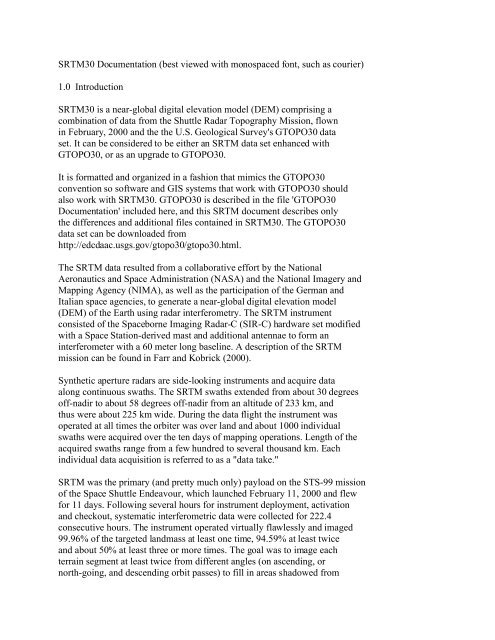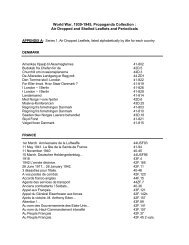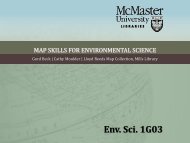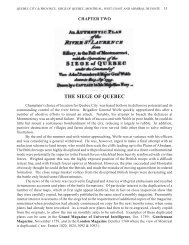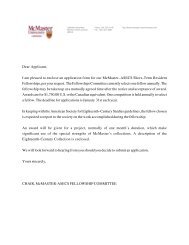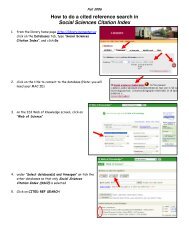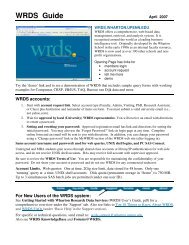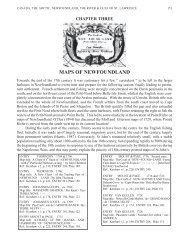SRTM30 Documentation (best viewed with monospaced font, such ...
SRTM30 Documentation (best viewed with monospaced font, such ...
SRTM30 Documentation (best viewed with monospaced font, such ...
Create successful ePaper yourself
Turn your PDF publications into a flip-book with our unique Google optimized e-Paper software.
<strong>SRTM30</strong> <strong>Documentation</strong> (<strong>best</strong> <strong>viewed</strong> <strong>with</strong> <strong>monospaced</strong> <strong>font</strong>, <strong>such</strong> as courier)<br />
1.0 Introduction<br />
<strong>SRTM30</strong> is a near-global digital elevation model (DEM) comprising a<br />
combination of data from the Shuttle Radar Topography Mission, flown<br />
in February, 2000 and the the U.S. Geological Survey's GTOPO30 data<br />
set. It can be considered to be either an SRTM data set enhanced <strong>with</strong><br />
GTOPO30, or as an upgrade to GTOPO30.<br />
It is formatted and organized in a fashion that mimics the GTOPO30<br />
convention so software and GIS systems that work <strong>with</strong> GTOPO30 should<br />
also work <strong>with</strong> <strong>SRTM30</strong>. GTOPO30 is described in the file 'GTOPO30<br />
<strong>Documentation</strong>' included here, and this SRTM document describes only<br />
the differences and additional files contained in <strong>SRTM30</strong>. The GTOPO30<br />
data set can be downloaded from<br />
http://edcdaac.usgs.gov/gtopo30/gtopo30.html.<br />
The SRTM data resulted from a collaborative effort by the National<br />
Aeronautics and Space Administration (NASA) and the National Imagery and<br />
Mapping Agency (NIMA), as well as the participation of the German and<br />
Italian space agencies, to generate a near-global digital elevation model<br />
(DEM) of the Earth using radar interferometry. The SRTM instrument<br />
consisted of the Spaceborne Imaging Radar-C (SIR-C) hardware set modified<br />
<strong>with</strong> a Space Station-derived mast and additional antennae to form an<br />
interferometer <strong>with</strong> a 60 meter long baseline. A description of the SRTM<br />
mission can be found in Farr and Kobrick (2000).<br />
Synthetic aperture radars are side-looking instruments and acquire data<br />
along continuous swaths. The SRTM swaths extended from about 30 degrees<br />
off-nadir to about 58 degrees off-nadir from an altitude of 233 km, and<br />
thus were about 225 km wide. During the data flight the instrument was<br />
operated at all times the orbiter was over land and about 1000 individual<br />
swaths were acquired over the ten days of mapping operations. Length of the<br />
acquired swaths range from a few hundred to several thousand km. Each<br />
individual data acquisition is referred to as a "data take."<br />
SRTM was the primary (and pretty much only) payload on the STS-99 mission<br />
of the Space Shuttle Endeavour, which launched February 11, 2000 and flew<br />
for 11 days. Following several hours for instrument deployment, activation<br />
and checkout, systematic interferometric data were collected for 222.4<br />
consecutive hours. The instrument operated virtually flawlessly and imaged<br />
99.96% of the targeted landmass at least one time, 94.59% at least twice<br />
and about 50% at least three or more times. The goal was to image each<br />
terrain segment at least twice from different angles (on ascending, or<br />
north-going, and descending orbit passes) to fill in areas shadowed from
the radar beam by terrain.<br />
This 'targeted landmass' consisted of all land between 56 degrees south and<br />
60 degrees north latitude, which comprises almost exactly 80% of the total<br />
landmass.<br />
1.1 Generation of <strong>SRTM30</strong><br />
SRTM radar echo data were processed into elevation information in a systematic<br />
fashion using the SRTM Ground Data Processing System (GDPS) supercomputer<br />
system at the Jet Propulsion Laboratory. Elevation data were mosaiced into<br />
more than 14,000 one degree by one degree cells and formatted according<br />
to the Digital Terrain Elevation Data (DTED) specification for delivery to<br />
NIMA, who is editing it and using it to update and extend their DTED<br />
products.<br />
Sample spacing for the fundamental data set is 1 arc-second in latitude<br />
and longitude (approximately 30 meters at the equator), consistent <strong>with</strong><br />
NIMA's existing DTED Level 2 product. By agreement between NIMA and NASA this<br />
product is under control of NIMA and is subject to limited distribution,<br />
using procedures similar to those for the existing DTED products.<br />
A second product, <strong>with</strong> sample spacing of 3 arc-seconds was generated by<br />
a 3x3 averaging of the 1 arc-second data, and is being systematically<br />
released to the public on a continent-by-continent basis. These 3<br />
arc-second data were then further averaged 10x10 to produce 30 arc-second<br />
data commensurate <strong>with</strong> GTOPO30.<br />
Since the SRTM elevation data delivered to NIMA are unedited, they contain<br />
occasional voids, or gaps, where the terrain lay in the radar beam's shadow<br />
or in areas of extremely low radar backscatter where an elevation solution<br />
could not be found. Globally these voids amount to no more than 0.15% of<br />
the SRTM data, but in some regions <strong>such</strong> as the Himalayas or northern Africa<br />
they are extensive enough to be evident even after the 10x10 averaging.<br />
To construct <strong>SRTM30</strong>, mosaics were constructed at 30 arc-second spacing in<br />
tiles that matched the GTOPO30 tiles. Then the results were combined <strong>with</strong><br />
GTOPO30 <strong>such</strong> that each sample contains an SRTM data point where SRTM data<br />
were valid, or GTOPO30 data where the SRTM data were void. Since the SRTM<br />
mission was only able to map up to approximately 60.25 degrees north<br />
latitude values above this point are completely from GTOP30.<br />
The geodetic reference for SRTM data is the WGS84 EGM96 geoid as documented<br />
at http://www.nima.mil/GandG/wgsegm/, and no attempt was made to adjust the<br />
vertical reference of either data set during the combination.
2.0 Data Format<br />
<strong>SRTM30</strong> has been divided into the same tiles as GTOPO30, except that<br />
since the data do not extend below 60 degrees south latitude the<br />
corresponding tiles, as well as the Antarctica file in GTOPO30, have<br />
not been generated.<br />
The following table lists the name, latitude and longitude extent, and<br />
elevation statistics for each <strong>SRTM30</strong> tile.<br />
Latitude Longitude Elevation<br />
Tile Minimum Maximum Minimum Maximum Minimum Maximum Mean Std.Dev.<br />
------- ---------------- ---------------- --------------------------------<br />
w180n90 40 90 -180 -140 -22 6098 448 482<br />
w140n90 40 90 -140 -100 -108 4635 731 596<br />
w100n90 40 90 -100 -60 -35 2416 337 280<br />
w060n90 40 90 -60 -20 -13 3940 1626 932<br />
w020n90 40 90 -20 20 -179 4536 402 426<br />
e020n90 40 90 20 60 -188 5472 213 312<br />
e060n90 40 90 60 100 -156 7169 509 697<br />
e100n90 40 90 100 140 -110 3901 596 455<br />
e140n90 40 90 140 180 -26 4578 415 401<br />
w180n40 -10 40 -180 -140 -3 4120 832 860<br />
w140n40 -10 40 -140 -100 -174 4228 1322 745<br />
w100n40 -10 40 -100 -60 -171 6543 367 609<br />
w060n40 -10 40 -60 -20 -22 2504 217 160<br />
w020n40 -10 40 -20 20 -138 3958 438 298<br />
e020n40 -10 40 20 60 -422 5778 724 557<br />
e060n40 -10 40 60 100 -46 8685 1807 1889<br />
e100n40 -10 40 100 140 -147 7213 690 911<br />
e140n40 -10 40 140 180 -42 4650 530 728<br />
w180s10 -60 -10 -180 -140 -41 1784 191 294<br />
w140s10 -60 -10 -140 -100 -5 910 79 133<br />
w100s10 -60 -10 -100 -60 -752 6813 1080 1359<br />
w060s10 -60 -10 -60 -20 -127 2823 411 294<br />
w020s10 -60 -10 -20 20 -24 2498 1088 404<br />
e020s10 -60 -10 20 60 -26 3408 889 453<br />
e060s10 -60 -10 60 100 -3 2557 251 262<br />
e100s10 -60 -10 100 140 -33 1360 290 172<br />
e140s10 -60 -10 140 180 -43 3119 278 265<br />
The 8 files included for each tile in GTOPO30 are also present in <strong>SRTM30</strong>, using<br />
the following extensions:
Extension Contents<br />
--------- --------<br />
DEM digital elevation model data<br />
HDR header file for DEM<br />
DMW world file<br />
STX statistics file<br />
PRJ projection information file<br />
GIF shaded relief image<br />
SRC source map<br />
SCH header file for source map<br />
In addition several additional files are included using these extensions:<br />
Extension Contents<br />
--------- --------<br />
dif difference between <strong>SRTM30</strong> and GTOPO30<br />
jpg color coded shaded relief image<br />
num number of valid point included in the 10x10 average<br />
std standard deviation of the elevations used in the average<br />
Further information on the contents of the files is provided below.<br />
2.1 DEM File (.DEM)<br />
Same as GTOPO30<br />
2.2 Header File (.HDR)<br />
Same as for GTOPO30<br />
2.3 World File (.DMW)<br />
Same as for GTOPO30<br />
2.4 Statistics File (.STX)<br />
Same as for GTOPO30<br />
2.5 Projection File (.PRJ)<br />
Same as for GTOPO30<br />
2.6 Shaded Relief Image (.GIF)
Same as for GTOPO30, except that brightness is also modulated by the elevation.<br />
This is a actually a greyscale version of the .jpg file noted below.<br />
2.7 Source Map (.SRC)<br />
Same as for GTOPO30, except a new source code has been added for SRTM data.<br />
The codes are now:<br />
Value Source<br />
----- ------<br />
0 Ocean<br />
1 Digital Terrain Elevation Data<br />
2 Digital Chart of the World<br />
3 USGS 1-degree DEM's<br />
4 Army Map Service 1:1,000,000-scale maps<br />
5 International Map of the World 1:1,000,000-scale maps<br />
6 Peru 1:1,000,000-scale map<br />
7 New Zealand DEM<br />
8 Antarctic Digital Database<br />
9 SRTM data<br />
2.8 Source Map Header File (.SCH)<br />
Same as for GTOPO30<br />
2.9 Difference file (.dif)<br />
16 bit signed integers indicating the difference between the <strong>SRTM30</strong> DEMs and<br />
the corresponding GTOPO30 tiles. Calculated as<br />
difference = <strong>SRTM30</strong> value - GTOPO30 value.<br />
2.10 Color Shaded Relief Image (.jpg)<br />
Color coded shaded relief image of the data in each file. Colors were assigned<br />
by elevation, then manipulated to produce a pleasing image - thus they cannot<br />
be related directly to elevation.<br />
2.11 Number of Points in Average (.num)<br />
8 bit integers indicating the number of valid data points that were included<br />
in the 10x10 averaging process.<br />
2.12 Standard Deviation (.std)
16 bit integers indicating the standard deviation of the data points used in<br />
the averaging. This is thus an indication of topographic roughness useful in<br />
some applications.<br />
3.0 References<br />
Farr, T.G., M. Kobrick, 2000, Shuttle Radar Topography Mission produces a<br />
wealth of data, Amer. Geophys. Union Eos, v. 81, p. 583-585.<br />
Rosen, P.A., S. Hensley, I.R. Joughin, F.K. Li, S.N. Madsen, E. Rodriguez,<br />
R.M. Goldstein, 2000, Synthetic aperture radar interferometry, Proc. IEEE,<br />
v. 88, p. 333-382.<br />
DMATR 8350.2, Dept. of Defense World Geodetic System 1984, Its Definition<br />
and Relationship <strong>with</strong> Local Geodetic Systems, Third Edition, 4 July 1997.<br />
http://164.214.2.59/GandG/tr8350_2.html<br />
Lemoine, F.G. et al, NASA/TP-1998-206861, The Development of the Joint NASA<br />
GSFC and NIMA Geopotential Model EGM96, NASA Goddard Space Flight Center,<br />
Greenbelt, MD 20771, U.S.A., July 1998.<br />
Other Web sites of interest:<br />
NASA/JPL SRTM: http://www.jpl.nasa.gov/srtm/<br />
NIMA: http://164.214.2.59/nimahome.html<br />
STS-99 Press Kit: http://www.shuttlepresskit.com/STS-99/index.htm<br />
Johnson Space Center STS-99:<br />
http://spaceflight.nasa.gov/shuttle/archives/sts-99/index.html<br />
German Space Agency: http://www.dlr.de/srtm<br />
Italian Space Agency: http://srtm.det.unifi.it/index.htm<br />
U.S. Geological Survey, EROS Data Center: http://edc.usgs.gov/<br />
Note: DTED is a trademark of the National Imagery and Mapping Agency


